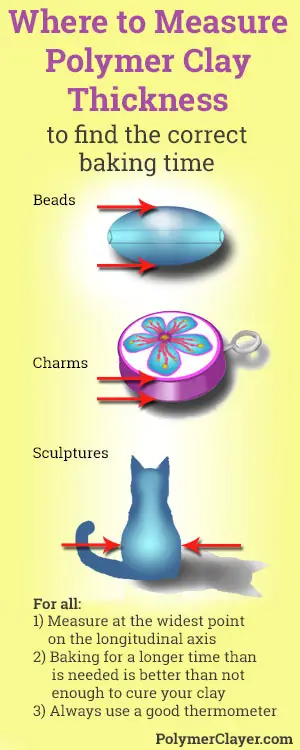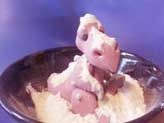How Do You Know When Your Sculpey Is Done Baking
Baking Polymer Clay Perfectly Every Time
Here's an like shooting fish in a barrel baking polymer clay chart where y'all tin can wait up bake times and oven temperatures by brand if you're in a rush. The rest of this article contains in-depth answers to mutual questions about polymer dirt baking problems and methods for cooking beads safely and beautifully.
To broil polymer clay, preheat your oven to the manufacturer's advised temperature (usually 230°F - 275°F). Baking times are typically 15 - 30 minutes for each ¼ inch thickness. Thinner clay needs 15 minutes to cure. When cool, properly baked clay can be marked with a fingernail, only information technology won't sink in.
It sounds elementary, but blistering to harden polymer clay can be the most frustrating office of clay crafts. Don't worry; you Can cure polyclay with confidence if you take a few piece of cake precautions. And you'll have a project to show off proudly every time!

Yous Only Have to Command 3 Things When You're Baking Polymer Clay
Temperature, Time, and Blistering Surfaces
Manage these and your oven will produce perfectly cured projects without scorching, burning or brittleness.
If you lot overcook your clay the only fashion to fix it is to encompass it up or sand information technology off. You lot can hide browning by calculation another layer and rebaking or painting over information technology. Be warned, sometimes sanding doesn't work because the scorch tin can go all the way through. Then getting baking correct the kickoff time is important.
So what are the 6 most important questions about baking polymer clay?
- Exercise y'all have to bake it?
- How practice you find the correct oven temperature?
- How can you tell when it's done?
- How long do y'all bake it?
- What's the all-time method for baking beads?
- Blistering on glass - Is it best? How to practise it?
Plus two Bonus Questions!
- Which thermometer'southward best for curing clay?
- How exercise you choose an oven?
#i: Do You lot Have to Broil Polymer Clay?
No. There is polymer air dry clay that dries at room temperature, simply it has a limited working time. And that makes sure techniques incommunicable, similar creating canes that have spreadable slices.
Most polymer 'oven clay' hardens and cures with sufficient heat for a long plenty time. There'due south no shortage of crazy means to cook clay. Information technology'southward been hardened with rut guns, cooked in electric roasters, tossed in fry pans on a bed of plaster of paris pulverisation, boiled, fried, and fifty-fifty microwaved. DON'T endeavor to cure your polymer piece by just sticking it in a microwave! What these crazy experimenters did was comprehend the polyclay with plenty of water and essentially boiled the water in the microwave.
Baking polymer clay isn't the only way, but it is the easiest and gives you control over the near important variables.
#2: How Practice You Notice the Correct Temperature?
As Albert might say about baking polymer clay, 'It own't rocket science kiddo!' Read the directions on the package. They will tell you the correct temperature to use and how long to cook it. There are iii exceptions:
- Are your translucent or light colored clays yellowing or scorching? Put some glazed ceramic tiles into your oven earlier blistering. Pre-heat for at to the lowest degree 15 minutes to get them hot. Place your pieces (and their holder similar a cookie sheet) on top of the ceramic tiles when blistering. They will concur heat and even out the oven's temperature after you open the door to put in your pieces.
- Get a Practiced separate thermometer (or two) and watch that oven temperature like a hawk. At some point information technology is getting likewise high and slightly burning or browning the clay. Your oven could also be 'spiking' (keep reading downwards this list for more info on this).
- Try dunking your slice into ice water immediately after taking it out of the oven. This halts any additional curing from residuum internal rut that may push the translucent over the edge from cured to yellowed. Practice NOT do this if you have inclusions that may absorb water or if your piece is built upon a porous armature. Watch out for newspaper, cardboard or wood.
- Reduce the oven's temperature past ten degrees C (18 F degrees) and double the cooking fourth dimension. Bake a testing sample and do a breakage test (come across the Test Baking box below)
- Keep your pieces as far away from the heating elements as possible. Consider curing your pieces in your larger habitation oven inside an oven baking bag.
- High tiptop baking If you are located at high altitudes (in a higher place 3,500 feet) Y'all'll need higher temperatures and a bit more time, just equally if you were baking a cake. Add 5 degrees to the recommended temperature, and 10 extra minutes. If in doubt, test a sample.
- Your oven temperature 'spikes' Some ovens are manufactured with a congenital in quick heating cycle and use a college temp than the dial setting in order to bring the average internal temperature up faster afterward the door is opened. Unfortunately this tin scorch translucent or thin pieces when yous're baking polymer dirt. If you find that y'all are burning projects even if you're using a adept thermometer, this might exist the problem. Here's what to do. Place ceramic tiles into your oven to bake on. And so preheat your oven to nigh 20 degrees below the manufacturer'south recommended temperature. Then place your piece in the oven for 10 minutes. Later the ten mins are up, set the dial to the correct temp. Start your stopwatch and and then bake for the normal time.
#3: How Practice Yous Know When Polymer Is Done Baking?
When polyclay is cured correctly, your cooled slice can exist marked when you printing a fingernail into it, but your boom won't sink in. It will be difficult to break, but if it is thin information technology might bend easily. It volition pause or cut cleanly, without a crumbly texture.
Of course the get-go hint that yous're finished baking polymer clay is when your kitchen timer dings. But information technology won't feel done. Polymer is quite soft when first removed from the oven. It needs to be cooled completely to reach its final hardness.
Test Blistering
Roll a chip of your clay mixture to the aforementioned thickness as the slice that you're blistering. Bake your sample.
Cut or intermission when completely cool to examine the interior for crumbling or brittleness.
#4: How Long Do You Broil Polymer Clay?
Cheque the packaging for basic instructions. And so ask yourself, "How deep is the thickest layer of unbaked clay?"
The duration of your blistering time depends upon the depth of the raw polyclay layer. If it's a bead, mensurate the distance from the eye to the surface.

If you've lost the package, but call back the brand, y'all can look up the correct temperature and cooking times in the chart below. It includes Fimo baking instructions and also applies to blistering Sculpey in a toaster oven.
In the nautical chart, oven blistering times that have been taken directly off the manufacturer's package are written in black type. Others are written thusly: **for every ane/4 inch (6mm) thickness** . The orange type is an estimate for those manufacturers that do not requite explicit blistering instructions for thicker layers. These companies print something nebulous about baking their polymer longer for thicker layers.
The general claying community consensus is to care for one/4 inch (6mm) as the 'standard' thickness and then add on that make'due south standard baking time unit for every multiple of the standard. It is recommended that you bake a examination sample first so you don't burn or under cook your piece. And...
NEVER leave your oven unattended when blistering dirt!
Polymer Clay Baking Instructions by Brand Proper noun Chart
Dirt Brand Temperature Oven Time Cernit 265°F (130°C) 30 minutes for every one/iv in (6mm) thickness Clayzee 248-302°F (120-150°C) 15 minutes **for every 1/4 inch (6mm)** Du-Kit 250°F (120°C) 10 minutes **for every 1/iv in (6mm) thickness** Fimo clay 230°F (110°C) 30 minutes **for every one/4 inch (6mm) thickness** Fimo Liquid 265°F (130°C) xx minutes Fimo Liquid with Fimo clay 265°F (130°C) xxx minutes Granitex 275°F (130°C) xv minutes for every one/4 in (6mm) thickness Kato Polyclay 275°F (135°C) xxx minutes **for every 1/4 in (6mm) thickness** Kato Liquid Polyclay - Matte terminate 300°F (150°C) 20 minutes Kato Liquid Polyclay - Glossy finish 350°F (177°C) 30 minutes Pluffy 275°F (130°C) xv minutes for every 1/four inch (6mm) thickness Premo 275°F (130°C) 30 minutes for every 1/4 inch (6mm) Sculpey Three 275°F (130°C) 15 minutes for every i/iv inch (6mm) thickness Sculpey - Original 275°F (130°C) 15 minutes for every 1/4 inch (6mm) thickness Souffle by Sculpey 275°F (130°C) 30 minutes for every 1/four inch (6mm) thickness Translucent Liquid Sculpey - when applied to solid clay 275°F (130°C) 15 to xx minutes Translucent Liquid Sculpey - by itself for Glossy cease 300°F (149°C) fifteen to xx minutes
#5: What Is The Best Method for Baking Polymer Dirt Beads?
This cloth softens a bit in the oven before the polymerization procedure is complete. This can cause apartment, shiny spots if you're baking on a difficult surface. To keep the shape that y'all desire, you need to rest your beads on a surface that conforms to the dewdrop or support information technology without resting it on a flat surface.
Many people employ bead baking trays similar this AMACO Bead Baking Rack.

I like these beading racks considering they fit easily into a standard toaster oven. They come with thick wire dewdrop supports that also work well for making holes to thread beading wire through.
Alternate support methods for baking polymer projects are:
| Put them in a poly fiber fill 'deject'. | Lay them in a basin filled with baking soda and partially cover them. After baking, clean with running water. | Residual the chaplet on paper 'troughs' folded from white, matte finish cardstock |
(Simply in instance you lot're wondering, my little pink dragon was made by the talented Kathy Davis.)
#half-dozen: Should You Be Baking Polymer Dirt on Drinking glass or Porcelain, or Ceramic Tile?
Many people pre-heat a glazed (non terra cotta) tile and and then transfer their creation on to it for baking using a sheet of ordinary white paper or matt finish cardstock like the back of an index card.
This does three things:
- The tile holds the heat, evening out the fluctuation caused by you opening the oven door. This is especially important if you're baking in a smaller toaster oven.
- Information technology prevents the shiny finish that will occur if you broil directly on the tile.
- Information technology keeps your piece flat while curing.
Source: https://www.polymerclayer.com/baking-polymer-clay.html#:~:text=%233%3A%20How%20Do%20You%20Know,cleanly%2C%20without%20a%20crumbly%20texture.



0 Response to "How Do You Know When Your Sculpey Is Done Baking"
Post a Comment